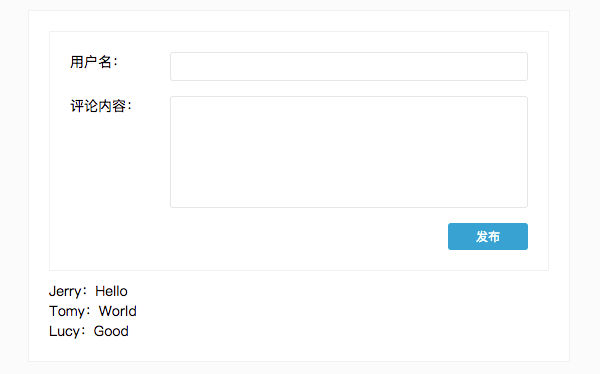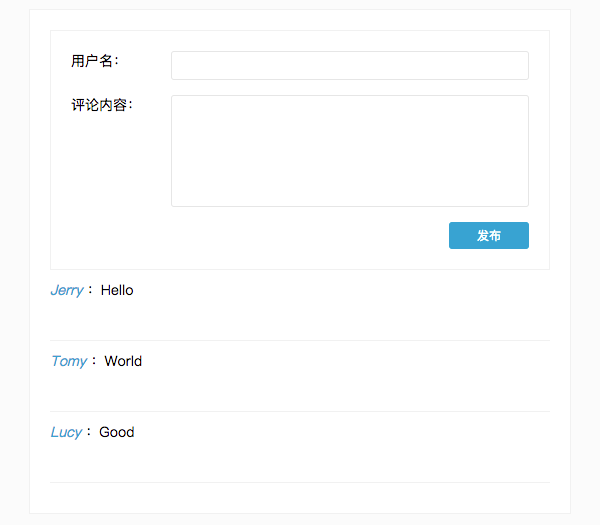React.js 小书
- 第一个阶段
- React.js 简介
- 前端组件化(一):从一个简单的例子讲起
- 前端组件化(二):优化 DOM 操作
- 前端组件化(三):抽象出公共组件类
- React.js 基本环境安装
- 使用 JSX 描述 UI 信息
- 组件的 render 方法
- 组件的组合、嵌套和组件树
- 事件监听
- 组件的 state 和 setState
- 配置组件的 props
- state vs props
- 渲染列表数据
- 实战分析:评论功能(一)
- 实战分析:评论功能(二)
- 实战分析:评论功能(三)
- 第二个阶段
- 前端应用状态管理 —— 状态提升
- 挂载阶段的组件生命周期(一)
- 挂载阶段的组件生命周期(二)
- 更新阶段的组件生命周期
- ref 和 React.js 中的 DOM 操作
- props.children 和容器类组件
- dangerouslySetHTML 和 style 属性
- PropTypes 和组件参数验证
- 实战分析:评论功能(四)
- 实战分析:评论功能(五)
- 实战分析:评论功能(六)
- 第三个阶段
- 高阶组件(Higher-Order Components)
- React.js 的 context
- 动手实现 Redux(一):优雅地修改共享状态
- 动手实现 Redux(二):抽离 store 和监控数据变化
- 动手实现 Redux(三):纯函数(Pure Function)简介
- 动手实现 Redux(四):共享结构的对象提高性能
- 动手实现 Redux(五):不要问为什么的 reducer
- 动手实现 Redux(六):Redux 总结
- 动手实现 React-redux(一):初始化工程
- 动手实现 React-redux(二):结合 context 和 store
- 动手实现 React-redux(三):connect 和 mapStateToProps
- 动手实现 React-redux(四):mapDispatchToProps
- 动手实现 React-redux(五):Provider
- 动手实现 React-redux(六):React-redux 总结
- 使用真正的 Redux 和 React-redux
- Smart 组件 vs Dumb 组件
- 实战分析:评论功能(七)
- 实战分析:评论功能(八)
- 实战分析:评论功能(九)
实战分析:评论功能(三)
接下来的代码比较顺理成章了。修改 CommentList 可以让它可以显示评论列表:
// CommentList.js
import React, { Component } from 'react'
class CommentList extends Component {
render() {
const comments = [
{username: 'Jerry', content: 'Hello'},
{username: 'Tomy', content: 'World'},
{username: 'Lucy', content: 'Good'}
]
return (
<div>{comments.map((comment, i) => {
return (
<div key={i}>
{comment.username}:{comment.content}
</div>
)
})}</div>
)
}
}
export default CommentList这里的代码没有什么新鲜的内容,只不过是建立了一个 comments 的数组来存放一些测试数据的内容,方便我们后续测试。然后把 comments 的数据渲染到页面上,这跟我们之前讲解的章节的内容一样——使用 map 构建一个存放 JSX 的数组。就可以在浏览器看到效果:
修改 Comment.js 让它来负责具体每条评论内容的渲染:
import React, { Component } from 'react'
class Comment extends Component {
render () {
return (
<div className='comment'>
<div className='comment-user'>
<span>{this.props.comment.username} </span>:
</div>
<p>{this.props.comment.content}</p>
</div>
)
}
}
export default Comment这个组件可能是我们案例里面最简单的组件了,它只负责每条评论的具体显示。你只需要给它的 props 中传入一个 comment 对象,它就会把该对象中的 username 和 content 渲染到页面上。
马上把 Comment 应用到 CommentList 当中,修改 CommentList.js 代码:
import React, { Component } from 'react'
import Comment from './Comment'
class CommentList extends Component {
render() {
const comments = [
{username: 'Jerry', content: 'Hello'},
{username: 'Tomy', content: 'World'},
{username: 'Lucy', content: 'Good'}
]
return (
<div>
{comments.map((comment, i) => <Comment comment={comment} key={i} />)}
</div>
)
}
}
export default CommentList可以看到测试数据显示到了页面上:
之前我们说过 CommentList 的数据应该是由父组件 CommentApp 传进来的,现在我们删除测试数据,改成从 props 获取评论数据:
import React, { Component } from 'react'
import Comment from './Comment'
class CommentList extends Component {
render() {
return (
<div>
{this.props.comments.map((comment, i) =>
<Comment comment={comment} key={i} />
)}
</div>
)
}
}
export default CommentList这时候可以看到浏览器报错了:
这是因为CommentApp 使用 CommentList 的时候并没有传入 comments。我们给 CommentList 加上 defaultProps 防止 comments 不传入的情况:
class CommentList extends Component {
static defaultProps = {
comments: []
}
...这时候代码就不报错了。但是 CommentInput 给 CommentApp 传递的评论数据并没有传递给 CommentList,所以现在发表评论时没有反应的。
我们在 CommentApp 的 state 中初始化一个数组,来保存所有的评论数据,并且通过 props 把它传递给 CommentList。修改 CommentApp.js:
import React, { Component } from 'react'
import CommentInput from './CommentInput'
import CommentList from './CommentList'
class CommentApp extends Component {
constructor () {
super()
this.state = {
comments: []
}
}
handleSubmitComment (comment) {
console.log(comment)
}
render() {
return (
<div className='wrapper'>
<CommentInput onSubmit={this.handleSubmitComment.bind(this)} />
<CommentList comments={this.state.comments}/>
</div>
)
}
}
export default CommentApp接下来,修改 handleSubmitComment :每当用户发布评论的时候,就把评论数据插入 this.state.comments 中,然后通过 setState 把数据更新到页面上:
...
handleSubmitComment (comment) {
this.state.comments.push(comment)
this.setState({
comments: this.state.comments
})
}
...小提示:这里的代码直接往
state.comments数组里面插入数据其实违反了 React.js 的state不可直接修改的原则 。但其实这个原则是为了shouldComponentUpdate的优化和变化的跟踪,而这种目的在使用 React-redux 的时候其实会自然而然达到,我们很少直接手动地优化,这时候这个原则就会显得有点鸡肋。所以这里为了降低大家的理解成本就不强制使用这个原则,有兴趣的朋友可以参考: Tutorial: Intro To React - React。
现在代码应该是可以按照需求正常运作了,输入用户名和评论内容,然后点击发布:
为了让代码的健壮性更强,给 handleSubmitComment 加入简单的数据检查:
...
handleSubmitComment (comment) {
if (!comment) return
if (!comment.username) return alert('请输入用户名')
if (!comment.content) return alert('请输入评论内容')
this.state.comments.push(comment)
this.setState({
comments: this.state.comments
})
}
...到这里,我们的第一个实战案例——评论功能已经完成了!完整的案例代码可以在这里 comment-app 找到, 在线演示 体验。
总结
在这个案例里面,我们除了复习了之前所学过的内容以外还学习了新的知识点。包括:
- 实现功能之前先理解、分析需求,划分组件。并且掌握划分组件的基本原则——可复用性、可维护性。
- 受控组件的概念,React.js 中的
<input />、<textarea />、<select />等元素的value值如果是受到 React.js 的控制,那么就是受控组件。 - 组件之间使用
props通过父元素传递数据的技巧。
当然,在真实的项目当中,这个案例很多地方是可以优化的。包括组件可复用性方面(有没有发现其实 CommentInput 中有重复的代码?)、应用的状态管理方面。但在这里为了给大家总结和演示,实现到这个程度也就足够了。
到此为止,React.js 小书的第一阶段已经结束,你可以利用这些知识点来构建简单的功能模块了。但是在实际项目如果要构建比较系统和完善的功能,还需要更多的 React.js 的知识还有关于前端开发的一些认知来协助我们。接下来我们会开启新的一个阶段来学习更多关于 React.js 的知识,以及如何更加灵活和熟练地使用它们。让我们进入第二阶段吧!
因为第三方评论工具有问题,对本章节有任何疑问的朋友可以移步到 React.js 小书的论坛 发帖,我会回答大家的疑问。



